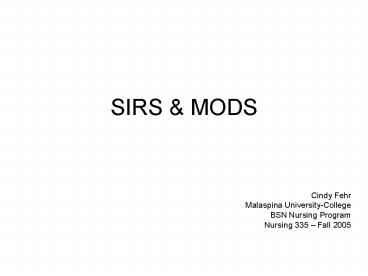SIRS - PowerPoint PPT Presentation
1 / 14
Title:
SIRS
Description:
Inflammation is immediate response to cellular injury. Triggered response to variety of causes. Ischemia, infection, trauma, ... RR 20 or respiratory alkalosis ... – PowerPoint PPT presentation
Number of Views:144
Avg rating:3.0/5.0
Title: SIRS
1
SIRS MODS
- Cindy Fehr
- Malaspina University-College
- BSN Nursing Program
- Nursing 335 Fall 2005
2
Inflammation
- Inflammation is immediate response to cellular
injury - Triggered response to variety of causes
- Ischemia, infection, trauma, foreign substances,
malignancies - Limited to specific area ? localized inflammation
- Large number or persistent inflammatory mediators
released ? generalized systemic inflammatory
response ? SIRS
3
SIRS
- Systemic Inflammatory Response Syndrome
- Common causes
- Massive trauma, burns, pancreatitis, septic shock
- Characterized by presence of any 2 of the
following clinical findings in response to tissue
injury - Temp gt 38C or lt 36C
- HR gt 90
- RR gt 20 or respiratory alkalosis
- WBC gt 12,000 or lt 4,000 cells/mm3 or gt 10
immature WBCs (bands) - Can lead to altered circulation coagulation
edothelial dysfunction impaired tissue perfusion
4
SEPSIS
- Syndrome on continuum
- When pt has findings of SIRS, PLUS, they have an
infection - Also known as a widespread inflammatory response
caused by infection
5
SEPSIS cont.
- Systemic Inflammation Characteristics
- Vasodilation of BV ? hypotension
- leaky capillaries ? ? bld circulating volume ?
worsening hypotension - ? metabolic rate
- ? microscopic clotting
- Persistence of these responses can lead to
impaired blood flow to organs ? organ dysfunction - Clinical Signs Symptoms
- Chills - hypotension
- ? skin perfusion - ? u/o
- Significant edema or fluid balance
- ? cap refill or mottling
- Hyperglycemia in absence of diabetes
- Unexplained change in mental status
6
Multisystem Effects of Shock
Source Hogan, M. A. Hill, K. (2004).
Pathophysiology reviews and rationales. Upper
Saddle River, New Jersey Prentice Hall.
7
SEPSIS cont.
- Severe Sepsis
- Sepsis associated with NEW organ dysfunction (1
or more organ systems), hypotension or
hypoperfusion - Septic Shock
- When organ failure in severe sepsis worsens and
no longer responds to fluid administration
(persistent arterial hypotension) vasoactive
drugs required to constrict BV
Organ Dysfunction Hypoperfusion
O2 defect Creatinine ? Coagulation abnormalities Thrombocytopenia Hyperbilirubinemia Ileus Acute oliguria High lactate Decreased capillary refill or mottling
8
Source Cheek, D.J., McGehee-Smith, H., Cunneen,
J., Cartwright, M. (2005). Sepsis Taking a
deeper look. Nursing 2005, 35(1), 38-42
9
Signs Symptoms of Organ Failure
Source Kleinpell, R.M. (2005). Working out the
complexities of severe sepsis, The Nurse
Practitioner, 30(4), 43-48
10
MODS
- Multiple Organ Dysfunction Syndrome
- Also known as Multiple Organ System Failure or
Mulitsystem Organ Failure - Often associated with sepsis and may affect any
organ - Respiratory, Cardiovascular and Renal systems
most often affected - Major cause of sepsis-related deaths
- Can happen in matter of hours or progress over
days or weeks - 10 MODS direct result of well-defined insult in
which organ dysfunction occurs early and is
directly attributable to the insult itself - 20 MODS develops as a consequence of a host
response (SIRS related)
11
Mediator Responses to Body Insult
- Stimulation of SNS fight or flight
- Damage to endothelial lining of BVs
- Activation of inflammatory/immune response
12
Pathophysiology of Multisystem Organ Failure
Source Huddleston, V. B. (1991). Multisystem
organ failure. Nursing 1991, September, 34-41.
13
Treatment Focus
- Aggressive treatment of underlying infection
- antibiotics
- Fluids
- Crystalloids (NS, LR) Colloids (hetastarch
PRBC) - Inotropic drugs vasopressors to increase tissue
perfusion - Inotropes (Dobutamine) ? boost strength of heart
contractions - Vasopressors (Norepinephrine, epinephrine,
phenylephrine, vasopressin or dopamine) ? support
BP via vasoconstriction - Targeted organ system support
- Mechanical ventilation, hemodialysis, tight
glycemic control, steroids for adrenal
insufficient - Activate Protein C
- ? inflammation coagulation, restore
fibrinolysis - SE ? risk of bleeding
14
- MODS difficult to reverse
- Prevention is the key
- Recognize hypoperfusion inflammatory response
put at large risk after significant damage - Normal physiologic processes that get out of
hand to unchecked can lead to MODS - Track trends stay alert for subtle changes that
can lead to devastating spiral into MODS - Aggressive treatment when first deterioration
noted - Collaborative work from all health team members































